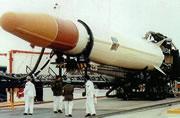 Remnants of thisThor Burner rocket collided with part of a Chinese rocket in space in January 2005.© Mark Wade /
Remnants of thisThor Burner rocket collided with part of a Chinese rocket in space in January 2005.© Mark Wade /Space could soon become too risky to visit unless derelict satellites and rockets are removed from orbit. That's the stark warning from a new simulation of space junk drifting around the Earth, and scientists are calling for swift international action to solve the problem.
"This is the first time we're going out there to ask for active removal of large debris from low Earth orbit," says J.-C. Liou of the orbital debris programme at NASA's Johnson Space Center, Houston, Texas.
More than 9,000 man-made objects currently orbit the Earth, and about two-thirds of those are debris. This includes derelict satellites, spent rockets and fragments of metal from explosions. With an estimated 5,000 tonnes of stuff flying around up there, its not surprising that US Space Command tries to track everything bigger than 10 centimetres, the size thought to present a fatal risk to spacecraft.
Liou and his colleague Nicholas Johnson used a computer model called LEGEND to predict what would happen to that space junk in the next 200 years, assuming that all space launches were halted in December 2004. That provides a 'best-case scenario', explains Liou; in reality, more and more metal is being shot into space each year.
Watch out!
The duo tracked fragments in low Earth orbit, which spans from 200 to 2,000 kilometres above the Earth's surface. Their simulation shows that without further space shots, the debris tally is stable until about 2055. But after that, the number of dangerous objects begins to rise again, as pieces of junk collide with each other and break up into smaller, yet still potentially fatal fragments.
Three such debris collisions are known to have happened since 1991 alone. The most recent, in January 2005, was between parts of a 31-year-old US rocket and a Chinese CZ-4 launch vehicle that exploded in March 2000.
"We only have one space," says Liou. "If we don't protect the space environment we might get to a stage where we can't launch satellites." The results are reported in this week's Science1.
Homeward bound
For the past ten years, major space agencies have ensured than anything launched into space will come back down to Earth within 25 years of its mission end date. They do this either by adjusting the object's original orbit so that it will inevitably fall back down, or by using the last remnants of fuel to guide an object home. The pieces then burn up as they hurtle through the atmosphere.
But that leaves many older satellites and pieces of junk still whizzing around. If we were to rely solely on gravity to bring these back to Earth, it would be thousands of years before space was clean again, says Liou.
The area between 900 and 1,000 kilometres altitude sees the densest concentration of debris. LEGEND calculates that about 60% of all catastrophic collisions, between junk and craft travelling through the mess, will occur in that range. The number of objects in this region is projected to triple by 2200.
Out of reach
None of the manned spacecraft currently in operation can reach beyond about 600 kilometres altitude, and the International Space Station orbits at just 350 kilometres. Although this means that they stay clear of the most dangerous zone, it also means that retrieving junk from further away will be extremely challenging. "We don't have a simple and cheap way to do it," says Liou.
ADVERTISEMENT
Robotic retrieval would be prohibitively expensive, and even the most powerful ground-based lasers don't have enough energy to nudge the junk into an orbit that will eventually bring it back to Earth.
Before a solution can be found, researchers first need international officials to agree that something needs to be done, says Liou. Johnson will put the scientists' case to members of the United Nations Committee on the Peaceful Uses of Outer Space on 27 February in Vienna, Austria.
